- Home
- Stephen E. Ambrose
Supreme Commander Page 6
Supreme Commander Read online
Page 6
Facing tactical reality did not mean abandoning strategic concepts.4 Marshall continued to ask Eisenhower for staff studies that would emphasize the importance of the second front and the British soon proved temporarily willing to accept Eisenhower’s conclusions. Agreement on a second front sometime in the future, after all, could and did lead to an immediate build-up of American forces, especially air forces, in the British Isles, which released British troops for the Middle East. Churchill and his advisers recognized as one of their major problems the need to keep Marshall and the American Army reasonably content, for Marshall could always threaten to turn away from Europe and go to the Pacific. Through the late winter and spring of 1942 each side was, in a sense, toying with the other, making concessions when necessary, insisting on fundamental points when they had to. It was a frustrating time for everyone, but especially for the Americans, since their potential power was so great, their actual strength so small, and their firmly held ideas so different from those of the British. It did not help that the role they were forced to play was that of supplicant.
The crucial problem was to obtain immediate agreement on the objective, both in order to aid Russia and to give some coherence to the American build-up. The United States was planning to raise two hundred divisions and the world’s largest air force. If this were done in a strategic vacuum the result would be chaos. As Eisenhower put it in a memorandum he prepared for Marshall on March 25, setting an objective would “govern training and production programs and will constitute a basis on which subsidiary decisions, involving necessary dispersion of forces, will be made.”
Eisenhower’s March 25 memorandum contained all of the arguments he had earlier advanced in favor of a Europe-first strategy and an early opening of the second front, but this time Eisenhower put the emphasis upon the need for decision. “The question of time is, of course, of the utmost importance,” he said. “Manifestly if all United Nations unified their most strenuous efforts toward preparation for a single agreed upon purpose the results that can be accomplished will bear no comparison to those that will follow disorganized, unintensive and diverse activity.”5
After reading the memorandum, Marshall penned a note on a separate slip of paper: “Hold for me. GCM.” He then went to have lunch at the White House with Stimson, Secretary of the Navy Frank Knox, Admiral King, General Arnold, Harry Hopkins, the President’s adviser, and Roosevelt. Marshall presented Eisenhower’s arguments for a cross-Channel attack. Roosevelt played the devil’s advocate, arguing for more intensive activity in the Pacific, but Marshall finally won him over. The President told the Chief to get the details worked out.6 By March 27 the OPD planners had outlined an invasion scheme indicating an April 1943 assault somewhere between Le Havre and Boulogne. Eisenhower and Handy, the head of OPD’s new Strategy and Policy Group, carefully reviewed the proposal before submitting it to Marshall on April 1.
The memorandum, entitled “Operations in Western Europe,” was thus a staff product, but throughout it carried Eisenhower’s personal touch. The main conclusions were his and of course they represented Marshall’s thought. The object of the plan was to convince the British that something could be done on the Continent before the Germans were on the verge of collapse and to satisfy the President that American troops would be fighting Germans before the end of the year.
The paper began with a restatement of the advantages of making western Europe the theater in which to stage the first Allied offensive. A new advantage concerned timing, on which OPD, at Roosevelt’s insistence, was becoming more specific. France offered “a unique opportunity to establish an active sector … this summer, through steadily increasing air operations and by raids or forays all along the coasts.” These operations would have the major advantage of providing “some help to Russia and immediate satisfaction to the public.” Even more important, OPD felt, they would make experienced veterans of the air and ground units and prevent the deterioration in morale which might otherwise come about as a result of prolonged inactivity. Much of the remainder of the paper consisted of detailed recommendations for the size and area of these raids.
The other main theme was what could be done by the Allies in 1943. Continuous staff study had shown that the United States could have, by the early spring of 1943, more than enough planes, troops, and equipment for an invasion. The two bottlenecks were shipping and landing craft. If the British would take up sixty per cent of the shipping, that problem could be solved; through intensive effort, the United States should be able to produce enough landing craft.
Assuming that the British were prepared to supply at least half the combat forces, OPD was prepared to recommend “an attack, by combined forces of approximately 5,800 combat airplanes and 48 divisions, against Western Europe as soon as the necesssry means can be accumulated in England—estimated at April 1, 1943, provided decision is made now and men, material and shipping are not further dispersed.” The attack would begin with a six-division assault between Le Havre and Boulogne.
OPD’s plan assumed that Russia, with the assistance of the raids against the French coast and lend-lease aid, could stay in the fight. If this assumption proved unfounded, the entire plan was academic. To deal with a changed situation, OPD included in the memorandum a modified plan, one which would be justified only if the situation on the Russian front became desperate, or the German situation in western Europe deteriorated. “Because of the emergency basis on which a modified plan would be undertaken,” OPD emphasized, “it is impossible to predict the time for its execution” or even the minimum scale on which it could be initiated. The only thing that was clear was that nothing could be done before September 1942.
The modified plan called for a suicide operation against France. The Allies would attempt to establish and hold a beachhead with what amounted to a large-scale raiding party. The major purpose would be to draw the German Air Force into a battle of destruction with the Royal Air Force and whatever American planes were available, under conditions favorable to the Allies, and thus relieve pressure on the Russians.7
The plan for an emergency landing in 1942 came to be known as SLEDGEHAMMER, the one for a permanent landing in 1943 became ROUNDUP. As soon as Eisenhower handed Marshall the OPD study the Chief, accompanied by Stimson, took it to the President. Roosevelt endorsed the proposal. Hopkins suggested that Marshall should take the plan directly to London. Roosevelt agreed, and directed Marshall and Hopkins to go at once to obtain support from Churchill and his military advisers. In early April they left for England.
For six days Marshall met daily with the British Chiefs of Staff to present the American plan.8 On April 14 the Bristish accepted the American proposal. The Japanese had just stepped up their activities in the Indian Ocean area and the British insisted that all necessary measures be taken to prevent a German-Japanese link-up in the Middle East. This was consistent with OPD thinking and the Americans readily agreed. Marshall was elated, but he recognized certain danger signs, reporting back to the War Department, “Everyone agrees … in principle but many if not most hold reservations regarding this or that.”9
The British had agreed to accept and implement Operation BOLERO, the build-up of American resources in the United Kingdom, aiming toward SLEDGEHAMMER (if necessary or possible) and more specifically toward ROUNDUP. British agreement meant OPD had won a great victory, but Eisenhower, like Marshall, was restrained. On April 20 he noted, “I hope that—at long last, and after months of struggle … we are all definitely committed to one concept of fighting! If we can agree on major purposes and objectives, our efforts will begin to fall in line and we won’t just be thrashing around in the dark.”10
The day he made the note, Eisenhower had a conference with Marshall to discuss organization for BOLERO planning. Major General James E. Chaney was already in London as commanding general of the U. S. Army forces in the British Isles. Marshall decided, for the present, to keep Chaney there to carry on the necessary negotiations with the British government for arrang
ements for the arriving American troops. Chaney would have serving under him an air commander, a ground crops commander for England, another corps commander for Northern Ireland, and an over-all Services of Supply (SOS) commander. Marshall wanted the corps commanders to spend some time in OPD before going over in order to familiarize themselves with the operation.11
With the organization presumably set, OPD began its detailed work. It quickly became clear that the fears Marshall and Eisenhower had expressed were real. On May 5 the War Department learned that the President, giving in to pressure from the Australian government, the Navy, and MacArthur, had decided to increase the U.S. ground forces in Australia by 25,000 men and the air forces there by 100 planes. Marshall asked Eisenhower to draft a memorandum to the President. Eisenhower had it ready that afternoon. Speaking for Marshall, Eisenhower began: “My mission to England was greatly embarrassed by the fact that we could propose only 2½ divisions to participate in a cross-channel operation by September 15th. Not only was this a very small force but in order to gather even that number of troops in the British Isles we were forced to set the late date of mid-September.” If 25,000 men went to Australia, it would make “it impossible for us to contribute more than a division and a half for the cross-channel operation.…”
The War Department would spend much of its time in the first year of the war pointing out to the President the implications of his meddling in military matters. Roosevelt had a tendency to thrust himself into the middle of a situation, give it a casual study, and then order this or that action. He often threw the whole operation into chaos. On the domestic front, during the New Deal, the practice had worked, even though it created a tizzy among the bureaucrats. During the war, when operations needed a lead time of six months for planning and involved millions of men and thousands of ships, interference in the middle of a situation meant the end of the operation.
Eisenhower made this perfectly clear. He emphasized that the two and a half divisions the Americans had offered the British for BOLERO were “insufficient” and had to be increased. If the President’s decision to send troops to Australia were implemented the result would be to cut the number of men available for BOLERO by fifty per cent. Eisenhower told Roosevelt that if his decision were carried out “our recent proposal to the British Government for 1942 has, in effect, largely been cancelled.” Roosevelt was, in short, making a decision against BOLERO.12
The next day the Navy entered the fray. Admiral King wrote Roosevelt to say that, “important as the mounting of BOLERO may be, the Pacific problem is no less so, and is certainly the more urgent—it must be faced now.” He said the United States needed enough force there “to hold what we have against any attack that the Japanese are capable of launching against us.” Marshall got a copy of King’s note and replied the same day. After reviewing the strategic debate that led to BOLERO and arguing that it “is impossible to make every point in the island chain impregnable,” he asked the President to make a decision between BOLERO and Australia.
Roosevelt was an expert in taking care of bickerings between agencies. As soon as he was aware of the issues involved he adroitly handled the Marshall-King dispute. On May 6 he told Marshall he had never issued a directive calling for an increase of strength in Australia, but had only asked if “this could properly be done.” He understood now that it was “inadvisable.” The President concluded bluntly, “I do not want ‘Bolero’ slowed down.”13
The incident had been settled in two days, but it left a heritage of apprehension in the War Department. Eisenhower noted that “Bolero is supposed to have the approval of the Pres and Prime Minister. But the struggle to get everyone behind it, and to keep the highest authority from wrecking it by making additional commitments of air-ships-troops elsewhere is never ending.” Turning to a more general theme, he sadly reflected, “The actual fact is that not 1 man in 20 in the Govt. (including the W. and N. Depts) realizes what a grisly, dirty, tough business we are in! They think we can buy victory!”
The President was not the only source of frustration. As early as February, Eisenhower had complained about the relative lack of urgency in the landing craft program. In May the problem was still there. The Navy had given top priority to building escorting vessels for convoys, a decision with which Eisenhower had no quarrel—there could be no BOLERO if the Americans could not get their convoys to England. Many of the nation’s shipyards concentrated on building merchant ships; again, Eisenhower obviously approved. The trouble was that the Navy also wanted to rebuild its capital ship fleet and as a result the landing craft program, despite verbal agreement as to its necessity, was stuck in a rut. From Eisenhower’s point of view there was no point to bringing men and equipment to England unless the landing craft were available to carry them the last few miles across the Channel. Even had he forgotten it, the British had not and would make sure the question remained at the fore, since their arguments against SLEDGEHAMMER and even ROUNDUP would center around the lack of landing craft.
Eisenhower, along with Hull and Wedemeyer of OPD, was a member of a subcommittee of the Washington BOLERO committee, called the “Special Committee on Landing Craft for the Continent.” On May 6, the day Roosevelt reiterated his support for BOLERO, Eisenhower attended a meeting of the subcommittee. The results were disappointing and at noon Eisenhower returned to his desk to ask, on his pad, some questions: “Who is responsible for bldg. landing craft? What types are they bldg? Are they suitable for cross channel work? Will the number of each type be sufficient? etc?” And finally, “How in hell can we win this war unless we can crack some heads?”14
On May 11 Eisenhower was able to turn his attention away from details and concentrate on the question of command structure in England. Major General Joseph T. McNarney, Marshall’s deputy chief of staff, had just submitted a proposed organizational chart under the heading “U.S. Set-up for Administrative Purposes.” McNarney’s chart showed, for the United States, the commanding general, and under him the commanders of U.S. ground forces, air forces, SOS, and naval forces. McNarney put the entire BOLERO operation under the BOLERO Task Force commander, presumably British, who would report to the CCS. Marshall asked Eisenhower to study McNarney’s chart and comment on it.15
Eisenhower began by questioning the advisability of McNarney’s use of the word “administrative,” since it implied definite limitations upon the authority of the officer. Eisenhower insisted that he should be “a Theater Commander in every sense of the word” with full responsibility. In the American Army the tradition was to delegate almost complete authority to the field commander, but this was not the British practice. He felt it was important to emphasize to the British the powers of the chief Army officer in England, so that the British would not be turning to Washington whenever an important question arose. This could be accomplished most easily by calling the top-ranking officer what he was, “Commander.”
In the bulk of his paper, Eisenhower commented on the type of officer needed to command the U.S. forces in England. The first requirement was that he have the full confidence of the Chief of Staff and be in full agreement with Marshall’s basic ideas. He had to be able to exercise command, for all activities of U.S. forces in the British Isles “must be cleared through him; otherwise his position will be intolerable.” Next, he had to be flexible, capable of playing any one of several roles, and able to “fit perfectly into the final organization—no matter what that may be.” BOLERO could take many forms, and Europe might become a secondary theater. In that case, the commanding general would unquestionably continue to serve as theater commander. If BOLERO developed as planned, and Europe became the critical theater, it was possible that the President would send Marshall himself to assume command, so the officer who had been serving as commanding general should be able to act as Marshall’s deputy or chief of staff. The officer should be selected immediately, and “the whole task of preparation in the United Kingdom should be turned over to him as rapidly as possible, and he should be allowed to car
ry out his task with a minimum interference from this end.”16
Marshall did not make an immediate selection; he evidently wanted to see how Chaney would work out. By May 21 he was concerned at the lack of progress, which he felt might be due to an absence of communication between Chaney and OPD. Marshall decided to send Eisenhower to London to bring Chaney up to date and to come back with recommendations on future organization. Eisenhower left on May 2, noting that he had “an uneasy feeling that either we do not understand our own C.G. and Staff in England or they don’t understand us. Our planning for Bolero is not progressing!”17
On Saturday, May 23, Eisenhower left Washington for Montreal. At 11:30 A.M. he flew on to Goose Bay, Labrador, leaving there in the late afternoon for England. Three hours out the weather forced his pilot to turn back, and he spent the night at Gander, Newfoundland. There was no break in the weather the next day, so he killed the time shooting skeet, his first day off in half a year. On May 25 he made it to Prestwick, Scotland, where he watched landing craft in operation, talked with some British officers, and visited the birthplace of Robert Burns.18 That evening he took the train to London, arriving early Tuesday morning, May 26.
He spent the next day in conference with Chaney and his staff, going in the evening to a dinner given by Air Chief Marshal Sir Charles F. Portal. The next day he observed a field exercise in the Kent-Sussex area, under the direction of the Army Commander in the Southeast, Lieutenant General Bernard Montgomery. Later he attended a lecture at which Montgomery explained the exercise. While the British general talked, Eisenhower lit a cigarette. He had taken about two puffs when Montgomery broke off in the middle of a sentence, sniffed the air without looking around, and in a loud voice demanded, “Who’s smoking?”

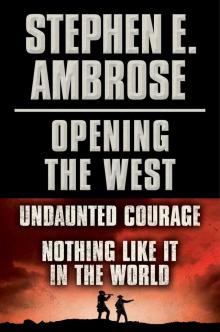 Undaunted Courage
Undaunted Courage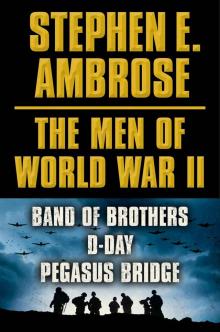 The Victors: Eisenhower and His Boys
The Victors: Eisenhower and His Boys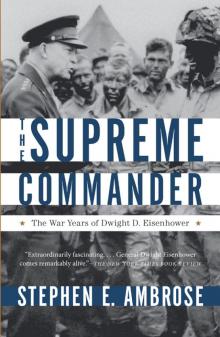 The Supreme Commander
The Supreme Commander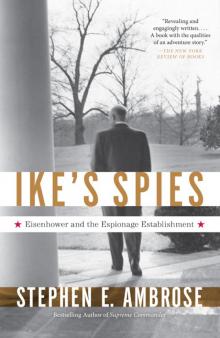 Ike's Spies: Eisenhower and the Espionage Establishment
Ike's Spies: Eisenhower and the Espionage Establishment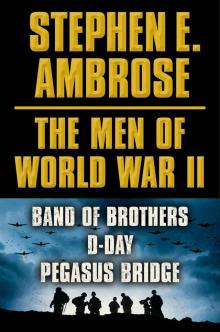 The Men of World War II
The Men of World War II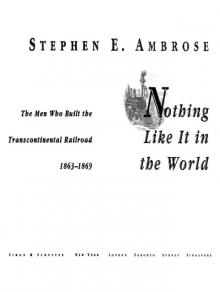 Nothing Like It in the World The Men Who Built the Transcontinental Railroad 1863-1869
Nothing Like It in the World The Men Who Built the Transcontinental Railroad 1863-1869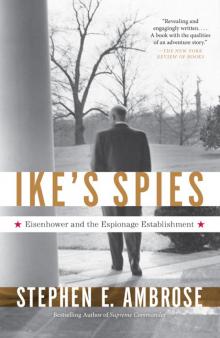 Ike's Spies
Ike's Spies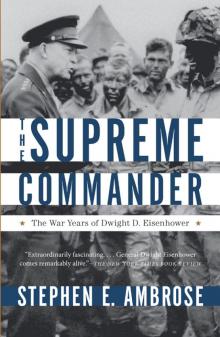 Supreme Commander
Supreme Commander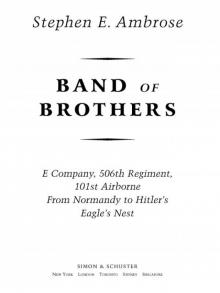 Band of Brothers
Band of Brothers